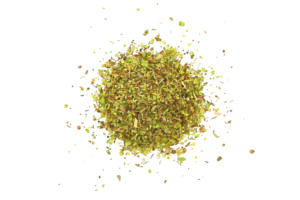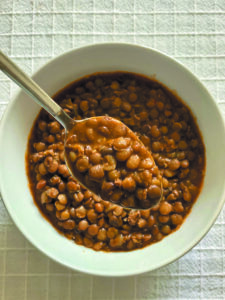Your heart pumps blood throughout your body. The arteries and veins through which blood flows to all of your organs, including the brain, can be negatively affected by high blood pressure, high cholesterol, smoking, inactivity, stress, genetics, and more. When arteries leading to the heart are damaged, it can cause a heart attack. Plaques in the brain can lead to dementia and Alzheimer’s. A complete blockage in an artery in the brain can cause a stroke, possibly resulting in loss of vision, movement, or the ability to speak.
Protecting your heart and the rest of your cardiovascular system is essential for overall wellness and quality of life—and your diet plays a major role in keeping you well. The healthiest eating patterns focus on fruits, vegetables, legumes, whole grains, nuts, seeds, healthy sources of protein, and plant-based oils, and are lower in added sugar, sodium, and saturated fat. Here are 10 principles and practices that are inspired by the Mediterranean, DASH (Dietary Approaches to Stop Hypertension), and MIND (Mediterranean-DASH Intervention for Neurodegenerative Delay) diets.
- Reduce sodium
Using less salt and choosing lower-
sodium ingredients is one way to reduce blood pressure. High blood pressure increases the risk of heart disease, kidney disease, and other diseases. It can also cause headaches, vision changes, and even anxiety.
- Cook with unprocessed or minimally processed ingredients.
- Choose a salt that contains less sodium per measure. We recommend Diamond Crystal Kosher Salt, which has 60 percent less sodium per measure than regular table salt due to the large, fluffy structure of the sodium chloride crystals.
- If you buy processed foods, compare nutrition labels among brands, and choose foods with less sodium.
- Explore spices
Use seasonings and spice blends that don’t rely on added salt for flavor. One of the keys to maximizing the flavor from herbs, spices, and seasoning blends is the freshness of the ingredients. Buying spices in their whole forms and grinding just what you need for a recipe can maximize freshness and flavor impact. When storing spice blends, limit exposure to air to protect flavor. Store blends in small zipper bags with as much air pressed out as possible, or in small resealable, airtight jars. We also recommend using freshly ground black pepper. Consider buying a pepper grinder: It makes a huge difference in enhancing the flavor of any dish.
Italian Seasoning
This versatile seasoning can be used in a wide variety of recipes.
Ingredients
- 2 Tbsp dried basil
- 2 Tbsp dried marjoram
- 1 Tbsp dried rosemary
- 2 Tbsp dried oregano
- 2 Tbsp dried sage
- 2 Tbsp dried savory
- 2 Tbsp dried thyme
- 1 tsp freshly ground black pepper
Directions
Whisk together the basil, marjoram, rosemary, oregano, sage, savory, thyme, and pepper in a small bowl. Use immediately or store in an airtight container in a cool, dark place for up to six months.
Makes ½ cup (25 g)

- Use good oil
We recommend and prefer a good-quality extra virgin olive oil (EVOO) for most recipes. In addition to contributing excellent flavor to dishes, EVOO contains mostly unsaturated fatty acids and beneficial phenols, natural plant substances that promote health in many ways. Not all olive oil at the store is authentic. To help choose a good oil, look for a harvest date and a third-party certification seal, such as the European Union’s Protected Designation of Origin or the “COOC Certified Extra Virgin” seal from the California Olive Oil Council.
If you want an inexpensive, neutral flavor, shelf-stable, multi-purpose oil, we recommend peanut oil.
- Make your sauces
Make your own sauces, salsas, and dressings to add additional flavors and textures to your food. A great sauce can add appealing flavors, textures, and even temperature contrast, plus added nutrition from the EVOO or other sources of unsaturated fat, as well as from added fruits, vegetables, nuts, seeds, herbs, and spices. Many of our sauces start with Greek yogurt as their base, and then are enlivened with added fresh dill, parsley or cilantro, chopped garlic, and finished with squirts of lemon or lime.
- Go whole grain
Use more whole-grain flours in your baking and add more intact whole grains to your meals. Whole grains from the familiar oatmeal and popcorn to lesser known farro, millet, and sorghum offer nutrition and health benefits. As you’re striving to eat more whole grains, keep in mind that perfect is the enemy of good. Try to make more of your grain choices whole grain, but don’t stress about choosing refined grain products for certain purposes.
- Boost fruits and vegetables
Research shows that people who eat the most fruits and vegetables—no matter how they are grown or processed—have the lowest risk of developing cardiovascular disease. This is just one of the many reasons we encourage people to buy and use canned, frozen, and dried fruits and vegetables in addition to fresh produce. Availability, convenience, and less food waste are other top reasons.
If you don’t like prepping produce, buy fresh-cut produce like shredded cabbage, washed and ready-to-use Romaine lettuce, diced onions, and tomatoes, peeled and cubed butternut squash, or diced melon. You can also use kitchen tools, like a food processor, to prepare onions, celery, and carrots for soup and stew bases or to shred cabbage for coleslaw.
- Choose proteins wisely
You can get plenty of healthy protein from both plants and animals. Research has shown that lean, unprocessed cuts of beef and pork can be part of a healthful Mediterranean-style eating pattern that reduces risk of cardiovascular disease by decreasing blood pressure, blood cholesterol, blood glucose, and inflammation. One trick for identifying leaner sources of beef and pork is to look for the term “loin” on the label.
Beans, chickpeas, and other legumes are good sources of plant protein. Pulses are inexpensive, shelf-stable, nutritious, filling, and very flavorful. If you love the convenience of canned beans, draining and rinsing them can reduce sodium content by up to 35 percent.
Try our fast and easy Simply Cooked Lentils recipe that can be served as a main dish or side; then use the remaining lentils as a key ingredient to make the Lentil Caprese Salad. Our secret in making the lentils so tasty that you’ll be enticed to eat them straight from the pot is to cook the lentils with a bay leaf. Many of our recipes are designed to cook once and eat twice.
- Eat more seafood
People who eat more seafood have a lower risk of cardiovascular disease. This includes all types of seafood, including convenience products like salmon, tuna, clams, and oysters that can make cooking with and eating fish and shellfish easier. One of the biggest benefits of cooking with seafood is how quickly much of it cooks. Broiling or grilling a piece of fish can put dinner on the table in a matter of minutes. Cooking en papillote is an easy way to cook fish in parchment paper packets without worrying about overcooking it.
While we hope you’ll cook more fish and shellfish at home, if you’d prefer to get your seafood in restaurants, go for it. Order the wood-grilled salmon for dinner one night and enjoy a tuna sandwich for lunch a few days later.
- Smart snacking
Snacking is a habit that can make significant contributions to meeting our daily nutrient needs, particularly if we choose our snacks thoughtfully with more nuts, fruits, vegetables, and low-fat dairy. Nuts are an easy and powerful snack option. Research shows that people who eat the most nuts, averaging about 5 ounces (150 g) per week, have the lowest risk of cardiovascular disease and a reduced risk of developing type 2 diabetes. (We offer many recipes for spiced nuts in Cooking à la Heart.)
- Enjoy dessert
Yes, desserts can be part of heart-healthy eating patterns. The key is to be thoughtful about how much and how often you eat them, and how they’re made. Focus on using more plant-based ingredients like fruit, vegetables, whole grains, nuts, seeds, dark chocolate, plant-based oils, and sweeteners like honey. Berries (blueberries, cranberries, strawberries, blackberries, and raspberries) have many health benefits; finding ways to eat and enjoy them more often will boost your cardiovascular health as well as your brain health.
We use whole-wheat pastry flour in many of our dessert recipes, and in many cases, we found we could replace butter with an alternative like extra virgin olive oil, but sometimes the best approach was to replace half the butter with oil.
Bottom line
There is no single dietary pattern best suited to every person, but there are traits common among eating patterns that predict better health outcomes, including greater consumption of fruits, vegetables, and other minimally processed plant-based foods. Healthful dietary patterns do not have to be low in total fat. The Mediterranean eating pattern contains more than 40 percent calories from fat, of which most is unsaturated fats from plant-based sources like olive oil. Eating a broad variety of foods across all food groups promotes greater nutrient intake, which can in turn promote better health outcomes. There are no superfoods, only super eating patterns.
The Principles of Cooking a la Heart
- Use less salt, and choose lower-sodium ingredients.
- Use more spice blends that don’t rely on added salt for flavor.
- Choose the best-quality oils for your cooking.
- Make sauces, salsas, and dressings to add additional flavors and textures to your food.
- Use more whole-grain flours in your baking, and add more intact whole grains to your meals.
- Use more fruits and vegetables in all their glorious forms in your cooking.
- Choose healthy sources of protein from plants and animals.
- Eat more seafood!
- Snack on nuts and other nourishing nibbles.
- Enjoy desserts made more thoughtfully with better-for-you ingredients.
Simply Cooked Lentils
Lentils are a favorite for their flavor and ease. They require no soaking prior to cooking. This recipe is so tasty you may want to eat them right from the pot.
Ingredients
- 1 cup (190 g) dry brown or green lentils, cleaned and rinsed
- 2½ cups (600 ml) water
- 1 bay leaf
- ¼ tsp freshly ground black pepper
- Juice of 1 lemon or ½ lime
Directions
- Place the lentils, water, bay leaf, and pepper in a medium saucepan. Bring to a boil, cover partially with a lid, and reduce the heat to a gentle simmer. Cook until the lentils are tender but still intact, 20 to 30 minutes.
- Remove from the heat, discard the bay leaf, and add the lemon or lime juice.
- Store in an airtight container in the refrigerator for up to four days. Freeze by dividing and packaging in one-cup (190 g) portions in airtight freezer-safe containers or heavy-duty bags. Press out as much air as you can. Seal, label, and freeze for up to four months. Thaw in the refrigerator overnight or place in a bowl of warm water, massaging every few minutes to break up the lentils.
Makes 2 cups (380 g)
Serving Size: 1 cup (190 g): Calories 240; Protein 18 g: Carbs 40 g; Dietary Fiber 16 g; Added Sugars: 0 g; Total Fat 1 g; Sat Fat 0 g; Omega-3s 0 mg; Sodium 12 mg; Potassium 919 mg

Lentil Caprese Salad
The addition of lentils to the classic caprese turns a starter salad into a complete meal. We suggest serving crusty fresh bread to make a memorable meal.
Ingredients
Balsamic Vinaigrette
- ¼ cup (60 ml) extra virgin olive oil
- 3 Tbsp balsamic vinegar
- 1 Tbsp fresh lemon juice
- 1 large garlic clove, minced
- 1 tsp Italian Seasoning (see recipe on p. 18)
- ½ tsp freshly ground black pepper
Salad
- 2 cups (380 g) Simply Cooked Lentils (see recipe on p. 19)
- One 8-ounce (227 g) container bite-size fresh mozzarella balls (bocconcini), drained
- 1½ cups (225 g) grape tomatoes, halved
- ¾ cup (20 g) fresh basil leaves, thinly sliced
Directions
Whisk together the oil, vinegar, lemon juice, garlic, seasoning, and pepper in a medium bowl. Add the lentils, mozzarella, tomatoes, and basil. Toss to combine and serve.
Makes 4 servings
Per Serving: Calories 405; Protein 16 g: Carbs 22 g; Dietary Fiber 10 g; Added Sugars: 0 g; Total Fat 26 g; Sat Fat 7 g; Omega-3s 120 mg; Sodium 384 mg; Potassium 526 mg


